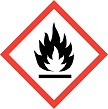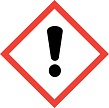GHS Classification Result
PHYSICAL HAZARDS
HEALTH HAZARDS
ENVIRONMENTAL HAZARDS
NOTE:
Reference:
Chemical Name:1-chloropropane
CAS:540-54-5
Result:
| ID: | 20A2116 |
| Classifier: | Ministry of Health, Labour and Welfare (MHLW), Ministry of the Environment (MOE) |
| Year Classified: | FY2008 |
| Reference Manual: | GHS Classification Guidance by the Japanese Government (Sep, 2008) |
PHYSICAL HAZARDS
| Hazard class | Classification | Symbol | Signal word | Hazard statement | Precautionary statement | Rationale for the classification | |
|---|---|---|---|---|---|---|---|
| 1 | Explosives | Not applicable | - | - | - | - | There are no chemical groups associated with explosive properties present in the molecules. |
| 2 | Flammable gases (including chemically unstable gases) | Not applicable | - | - | - | - | Liquid (GHS definition) |
| 3 | Aerosols | Not applicable | - | - | - | - | Not aerosol products. |
| 4 | Oxidizing gases | Not applicable | - | - | - | - | Liquid (GHS definition) |
| 5 | Gases under pressure | Not applicable | - | - | - | - | Liquid (GHS definition) |
| 6 | Flammable liquids | Category 2 |

|
Danger | H225: Highly flammable liquid and vapour |
P303+P361+P353: IF ON SKIN (or hair): Remove/Take off immediately all contaminated clothing. Rinse skin with water/shower. P370+P378: In case of fire: Use ... for extinction. P403+P235: Store in a well-ventilated place. Keep cool. P210: Keep away from heat/sparks/open flames/hot surfaces. ? No smoking. P233: Keep container tightly closed. P240: Ground/bond container and receiving equipment. P241: Use explosion-proof electrical/ventilating/lighting/.../equipment. P242: Use only non-sparking tools. P243: Take precautionary measures against static discharge. P280: Wear protective gloves/protective clothing/eye protection/face protection. P501: Dispose of contents/container to ... |
Its flash point is -18degC, which is below 23degC, and its boiling point is 47degC, which is above 35degC. The substance fits in UNRTDG Class 3 II. |
| 7 | Flammable solid | Not applicable | - | - | - | - | Liquid (GHS definition) |
| 8 | Self-reactive substances and mixtures | Not applicable | - | - | - | - | There are no chemical groups present in the molecule associated with explosive or self-reactive properties. |
| 9 | Pyrophoric liquids | Not classified | - | - | - | - | Its autoignition point is 520degC (Chapman Ver. 16, 1 (2008)), which is above 70degC. |
| 10 | Pyrophoric solids | Not applicable | - | - | - | - | Liquid (GHS definition) |
| 11 | Self-heating substances and mixtures | Classification not possible | - | - | - | - | Test methods applicable to liquid substances are not available. |
| 12 | Substances and mixtures which, in contact with water, emit flammable gases | Not applicable | - | - | - | - | The chemical structure of the substance does not contain metals or metalloids (B, Si, P, Ge, As, Se, Sn, Sb, Te, Bi, Po, At). |
| 13 | Oxidizing liquids | Not applicable | - | - | - | - | The substance contains chlorine (but not oxygen), which is chemically bonded only to carbon. |
| 14 | Oxidizing solids | Not applicable | - | - | - | - | Liquid (GHS definition) |
| 15 | Organic peroxides | Not applicable | - | - | - | - | Containing no bivalent -O-O- structure in the molecule |
| 16 | Corrosive to metals | Classification not possible | - | - | - | - | Test methods applicable to liquid substances (boiling point <= 55degC) are not available. |
| Hazard class | Classification | Symbol | Signal word | Hazard statement | Precautionary statement | Rationale for the classification | |
|---|---|---|---|---|---|---|---|
| 1 | Acute toxicity (Oral) | Classification not possible | - | - | - | - | It is documented that in a test, rats survived at a single oral dose of 1 g/kg but died when given 3 g/kg (HSDB (2003)). However, its Category cannot be specified, and the substance cannot be classified. As relevant information, it is rated R22 in the EU classification (EU-Annex 1 (accessed in August 2008)). |
| 1 | Acute toxicity (Dermal) | Classification not possible | - | - | - | - | No data available. |
| 1 | Acute toxicity (Inhalation: Gases) | Not applicable | - | - | - | - | Liquid (GHS definition) |
| 1 | Acute toxicity (Inhalation: Vapours) | Classification not possible | - | - | - | - | It is documented that its TCLo = 8.1 mg/L/2H = 5.7 mg/4H = 1775 ppm/4H for rats (RTECS (2004)). However, since its LC50 cannot be determined, classification is not possible. As relevant information, it is rated R20 in the EU classification (EU-Annex 1 (accessed in August 2008)). |
| 1 | Acute toxicity (Inhalation: Dusts and mists) | Classification not possible | - | - | - | - | No data available. |
| 2 | Skin corrosion/irritation | Classification not possible | - | - | - | - | It is described that after repeated exposure, the substance was only slightly irritating to the skin of rabbits (HSDB (2003)). However, since there is no other data available, classification is not possible. |
| 3 | Serious eye damage/eye irritation | Classification not possible | - | - | - | - | It is documented that when the substance was tested externally on the eyes of rabbits, and rated on a scale of 1 to 10, and the most severely injurious substances had been rated 10, the substance rated 2 (HSDB (2003)). However, since details of the test are not indicated, classification is not possible. |
| 4 | Respiratory sensitization | Classification not possible | - | - | - | - | No data available. |
| 4 | Skin sensitization | Classification not possible | - | - | - | - | No data available. |
| 5 | Germ cell mutagenicity | Not classified | - | - | - | - | Since the substance was negative in a germ cell in vivo multi-generation mutagenicity test (a dominant lethal test with rats) (PATTY (5th, 2001)). |
| 6 | Carcinogenicity | Classification not possible | - | - | - | - | No data available. |
| 7 | Reproductive toxicity | Classification not possible | - | - | - | - | No data available. |
| 8 | Specific target organ toxicity - Single exposure | Category 3 (Narcotic effects) |

|
Warning | H336: May cause drowsiness or dizziness (narcotic effects) |
P304+P340: IF INHALED: Remove victim to fresh air and keep at rest in a position comfortable for breathing. P403+P233: Store in a well-ventilated place. Keep container tightly closed. P261: Avoid breathing dust/fume/gas/mist/vapours/spray. P271: Use only outdoors or in a well-ventilated area. P312: Call a POISON CENTER or doctor/physician if you feel unwell. P405: Store locked up. P501: Dispose of contents/container to ... |
Inhalation exposure was reported to be anesthetic in mice (RTECS (2004); PATTY (5th, 2001)). Furthermore, the substance is described to be a central nervous system depressant in humans (HSDB (2003)). Therefore, the substance was classified into Category 3 (narcotic effects). |
| 9 | Specific target organ toxicity - Repeated exposure | Classification not possible | - | - | - | - | No data available. |
| 10 | Aspiration hazard | Classification not possible | - | - | - | - | No data available. |
| Hazard class | Classification | Symbol | Signal word | Hazard statement | Precautionary statement | Rationale for the classification | |
|---|---|---|---|---|---|---|---|
| 11 | Hazardous to the aquatic environment (Acute) | Classification not possible | - | - | - | - | No data available. |
| 11 | Hazardous to the aquatic environment (Long-term) | Classification not possible | - | - | - | - | No data available. |
NOTE:
|
* Classification was conducted by relevant Japanese Ministries in accordance with GHS Classification Guidance for the Japanese Government, and is intended to provide a reference for preparing GHS labelling and SDS for users. * This is a provisional English translation of classification results and is subject to revision without notice. * The responsibility for any resulting GHS labelling and SDS referenced from this site is with users. |
Reference:
|
Reference Manual |
|
|
Definitions / Abbreviations |
|
|
Model Label by MHLW |
MHLW Website (in Japanese Only) |
|
Model SDS by MHLW |
MHLW Website (in Japanese Only) |